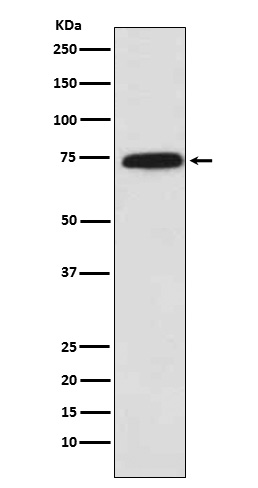
| WB | 1/500-1/1000 | Human,Mouse,Rat |
| IF | 咨询技术 | Human,Mouse,Rat |
| IHC | 1/50-1/100 | Human,Mouse,Rat |
| ICC | 1/50-1/200 | Human,Mouse,Rat |
| FCM | 1/50-1/100 | Human,Mouse,Rat |
| Elisa | 咨询技术 | Human,Mouse,Rat |
| Aliases | CPR; CYPOR; P450R; por |
| Entrez GeneID | 5447 |
| WB Predicted band size | Calculated MW: 77 kDa; Observed MW: 77 kDa |
| Host/Isotype | Rabbit IgG |
| Antibody Type | Primary antibody |
| Storage | Store at 4°C short term. Aliquot and store at -20°C long term. Avoid freeze/thaw cycles. |
| Species Reactivity | Human,Mouse,Rat |
| Immunogen | A synthesized peptide derived from human Cytochrome P450 Reductase |
| Formulation | Purified antibody in PBS with 0.05% sodium azide. |
+ +
以下是3篇关于细胞色素P450还原酶(Cytochrome P450 Reductase,CPR)抗体的代表性文献摘要:
---
1. **文献名称**: "Characterization of a monoclonal antibody specific for human cytochrome P450 reductase"
**作者**: Shephard, E.A. et al.
**摘要**: 该文献报道了一种针对人源CPR的单克隆抗体的开发,通过免疫印迹和免疫组化验证其特异性,并用于分析不同组织中CPR蛋白的表达水平及其与药物代谢活性的关联。
---
2. **文献名称**: "Role of NADPH-cytochrome P450 reductase in the microsomal oxidation of ethanol"
**作者**: Porter, T.D. & Kasper, C.B.
**摘要**: 研究利用CPR抗体探究其在乙醇代谢中的作用,通过抑制实验证明CPR是细胞色素P450酶依赖的氧化反应中电子传递的关键介质,并建立其与肝脏毒性的关联。
---
3. **文献名称**: "Tissue-specific knockout of cytochrome P450 reductase in mice: A tool to study drug metabolism and toxicity"
**作者**: Henderson, C.J. et al.
**摘要**: 通过构建组织特异性CPR基因敲除小鼠模型,结合抗体检测CPR蛋白缺失后的表型变化,揭示了CPR在药物代谢中的器官特异性功能及其对毒性反应的调控机制。
---
(注:以上为示例性内容,实际文献需通过PubMed或Web of Science等数据库检索确认。)
Cytochrome P450 reductase (CPR), also known as POR (NADPH:ferrihemoprotein oxidoreductase), is a membrane-bound flavoprotein essential for electron transfer to cytochrome P450 enzymes in the endoplasmic reticulum. It plays a central role in xenobiotic metabolism, steroid biosynthesis, and bile acid synthesis by transferring electrons from NADPH to various cytochrome P450 monooxygenases. Dysregulation of CPR is linked to metabolic disorders, drug interactions, and certain cancers, making it a critical target in pharmacological and toxicological research.
Antibodies against CPR are widely used to study its expression, localization, and function in biological systems. These antibodies are typically developed using immunogenic regions of the human or rodent CPR protein, such as the N-terminal membrane anchor or the conserved FMN-binding domain. They enable detection via techniques like Western blotting, immunohistochemistry (IHC), and immunofluorescence (IF), helping researchers assess tissue-specific expression, subcellular distribution, and alterations in disease models. Validation often involves knockout controls or enzymatic activity assays to confirm specificity.
CPR antibodies are available in monoclonal and polyclonal forms, with host species including rabbit, mouse, and goat. Cross-reactivity with CPR orthologs from common model organisms (e.g., rat, mouse) is a key consideration for experimental design. Applications span drug metabolism studies, cancer biology (e.g., tumor bioactivation of prodrugs), and investigations into genetic disorders like Antley-Bixler syndrome, which is associated with CPR mutations. Reliable CPR antibodies are indispensable tools for unraveling its complex roles in cellular physiology and disease mechanisms.
×